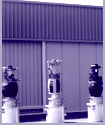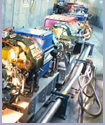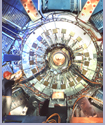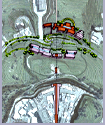SLAC Tours
Tours of SLAC will be given Wednesday, August 1 and Wednesday, August 8 from 3:00pm to 5:00pm. Tours meet promptly at 2:45pm in the auditorium breezeway. Interested SSI participants will have the opportunity to sign up for the tours in the auditorium lobby.
| Klystron Gallery and Overlook | |
|
Klystrons as far as the eye can see generate the microwaves which power the SLAC linac. A stop at the Visitor’s Gallery along the two mile accelerator, shows the critical linac components, explains their workings, and provides a spectacular visual experience. A “must-see” at SLAC. |
 |
| SSRL | |
|
The Stanford Synchrotron Radiation Laboratory, a division of Stanford Linear Accelerator Center, is operated by Stanford University for the Department of Energy. SSRL is a National User Facility which provides synchrotron radiation, for a wide variety of experiments. These extremely bright x-rays can be used to investigate various forms of matter ranging from objects of atomic and molecular size to man-made materials with unusual properties. The obtained information and knowledge obtained is of great value to society, with impact in areas such as the environment, future technologies, health, and national security. |
 |
| BABAR | |
|
The B-Factory is SLAC's premier high energy physics program and is investigating the matter-antimatter asymmetry observed in nature. The BaBar detector consists of a silicon vertex detector, a drift chamber, a novel particle identification system called the DIRC, a Csl electromagnetic calorimeter, and a magnet with an instrumented flux return; it looks like an organized conglomeration of steel, crystals, and wires. |
 |
| LCLS Construction Site | |
|
The LCLS will be the world's first x-ray free electron laser when it becomes operational in 2009. LCLS is currently in the construction phase. Pulses of x-ray laser light from LCLS will be many orders of magnitude brighter and several orders of magnitude shorter than what can be produced by any other x-ray source available now or in the near future. These characteristics will enable frontier new science in areas that include discovering and probing new states of matter, understanding and following chemical reactions and biological processes in real time, imaging chemical and structural properties of materials on the nanoscale, and imaging non-crystalline biological materials at atomic resolution. |
 |
